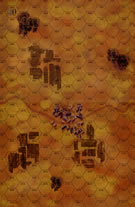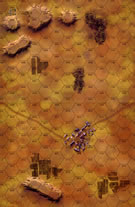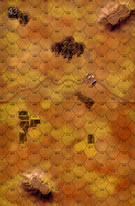|
Kempf VI: Like Dominoes They Fell Burning Tigers #6 |
||
|---|---|---|
| (Attacker) Germany | vs | Soviet Union (Defender) |
| Formations Involved | ||
|---|---|---|
| Germany |  |
19th Panzer Division |
| Soviet Union |  |
305th Rifle Division |
| Soviet Union |  |
92nd Guards Rifle Division |
| Soviet Union |  |
96th Tank Brigade |

| Total | |
|---|---|
| Side 1 | 3 |
| Draw | 0 |
| Side 2 | 1 |
| Overall Rating, 5 votes |
|---|
|
4.2
|
| Scenario Rank: 42 of 913 |
| Parent Game | Burning Tigers |
|---|---|
| Historicity | Historical |
| Date | 1943-07-11 |
| Start Time | 09:15 |
| Turn Count | 22 |
| Visibility | Day |
| Counters | 169 |
| Net Morale | 1 |
| Net Initiative | 2 |
| Maps | 3: 40, 42, 43 |
| Layout Dimensions | 84 x 43 cm 33 x 17 in |
| Play Bounty | 179 |
| AAR Bounty | 159 |
| Total Plays | 4 |
| Total AARs | 3 |
| Battle Types |
|---|
| Delaying Action |
| Exit the Battle Area |
| Urban Assault |
| Conditions |
|---|
| Entrenchments |
| Minefields |
| Off-board Artillery |
| Randomly-drawn Aircraft |
| Smoke |
| Scenario Requirements & Playability | |
|---|---|
| Burning Tigers | Base Game |
| Introduction |
|---|
|
Reviewing the first week of Operation Citadel, the headquarters staff at Army Detachment Kempf found agonizingly slow progress, with its 6th Panzer Division suffering the loss of over half of its armor. In one last desperate attempt to effect a breakout, Detachment headquarters ordered the 19th Panzer Division to assist 6th Panzer Division by advancing on the east bank of the Northern Donets River. They hoped that giving the Soviets two advancing forces on either side of the river would divide the defenders' attention enough to overcome them. |
| Conclusion |
|---|
|
Adding a second panzer division finally moved III Panzer Corps forward. The 6th Panzer Division advanced six miles and secured Kazachie while 19th Panzer Division stormed through Khokhlovo, Kiselevo and Sabynino before halting for the night. They shredded 7th Guards Army's defenses beyond repair, forcing that formation to send out a frantic cry for help that evening. |
| AFV Rules Pertaining to this Scenario's Order of Battle |
|---|
|
| 5 Errata Items | |
|---|---|

|
The reduced direct fire value of the Heer HMG became 5-5 starting with Fall of France. (plloyd1010
on 2015 Jul 31)
|

|
All SS PzIVH tanks should have a movement of 8. (Shad
on 2010 Dec 15)
|

|
The morale and combat modifiers of German Sergeant #1614 should be "0", not "8". (Shad
on 2010 Dec 15)
|

|
The reduced direct fire value in Kursk: Burning Tigers is 4-4. (plloyd1010
on 2015 Jul 31)
|

|
Kommissars never get morale or combat modifiers. Ignore misprints. (Shad
on 2010 Dec 15)
|
| Dominos...With Headstones | ||||||||||||
|---|---|---|---|---|---|---|---|---|---|---|---|---|
The German attack looked to be sneaky, bypassing the Soviet strongpoint on map 43, engaging it with 2 companies of infantry and some support. But, the Soviets disrupted the bypassing Germans with arty/OBA. The Germans did manage to capture (the Soviets didn’t defend) Kiselevo. The Germans never really got on track, with DF added to the mix when they got within range of the units around Sabynino. For the Germans it was very frustrating to see each probe and mass for attack either disrupted or stopped short. For the Soviets, vodkas all around. |
||||||||||||
| 0 Comments |
| Kiselevo becomes a "mini-Stalingrad"! | ||||||||||||
|---|---|---|---|---|---|---|---|---|---|---|---|---|
On the morning of July 11, 1943, elements of the 19th Panzer Division on the southern flank of Army Detachment Kempf were sent north to assist 6th Panzer Division to secure a foothold along the Northern Donets River. They encountered Soviet troops from the 92nd Guards Rifle Division, 305th Rifle Division and 96th Tank Brigade. The primary objectives of the German campaign were to secure the towns of Sabynino and Kiselevo, while breaking though the Soviet lines to the north. The Guards were positioned 2Km east of Kisolevo with a picket set up on the farm SE of the town. The 305th Rifle Division was set up primarily west/southwest of town with a heavy concentration in Sabynino and entrenchments in the fields surrounding the city. Armor and infantry were positioned around the woods approx. 1 Km west of Kisolevo and ready to move quickly east into the town. Two T-34’s were also assigned to support the Guards east of town. The German divisions made a strong push directly toward Kiselevo in an attempt to split the Soviet forces, with minor thrusts on both flanks. The Soviets countered by quickly moving both tanks and wagons into Kiselevo. However, by 1030, the German Panzers had eliminated both a T-34C and T-34B from the town. In the ensuing battle over the next hour, the Germans continued to press forward, eliminating two more tanks (a T-34C and T-70) from Kiselevo as well as a number of infantry and HMG platoons. By 1130, another T-34B was eliminated and the town was being heavily assaulted by German troops; the Germans had only lost two AFV’s to this point, a Pz.IIIJ and a Marder, the last to an attack by an IL-2M. Assaults on the town itself followed with the loss of the Kommissar at noon, and thinking that the attack on the town was winding down, some troops began to shift their attention SW toward the well-fortified Sabynino. By 1230, the last T-34C was forced to retreat from Kiselevo, and it was subsequently destroyed by an Hs.129 attack. The Soviet response had been to shift the 92nd Guards Rifle Division from the east to the hills north of town to prepare for a counterattack, where they were met by two Panzers on the prowl northward. Between 1300 and 1400 hours, two German engineers were lost trying to clear the minefields around Sabynino, while Soviet troops began to slowly move from that town NE to aid the remaining SMG platoons that were still bravely holding their ground in Kiselevo. The German Panzers and their supporting troops finally managed to clear the last Soviet SMG platoon from Kiselevo at 1430 and were able to secure the town, but the beleaguered tank-riders were heralded as heroes of the Soviet Union for their endurance in the face of strong German firepower. At that point, the battlefield was awash with disrupted and demoralized troops, and neither side was in any position to mount a counterattack. The Germans had secured their route to the north through Kiselevo, but conquest of Sabynino would have to wait for another day. The Germans had at least secured a minor victory. This 3-map scenario has the following objectives: German need to exit 20 steps off the north edge, and secure both towns of Sabynino and Kiselevo for a major victory, while the Soviets need to prevent these three objectives from being reached. Soviet setup is made slightly difficult since all units must be placed on either Map 40 or 43, which leaves Kiselevo and the entire center unprotected. Strong Soviet positions were set up on both flanks, with a mobile force or T-34’s and SMG riders ready to move to the center quickly. AT guns were well emplaced across both flanks with some firing lines into the center map. The German strategy could be to either take Sabynino or Kiselevo first in a show of force, since the Germans have twice as many tanks as the Soviets, with stronger armor and efficiency allowing two AT shots per turn; this results in 28 AT shots per turn to 7 for the Soviet tanks. Both sides also have AT artillery and rifles, but these are much less mobile. The strategy used by the Germans here was to push for Kiselevo first, which would create a putative route for unit exits around either side of the ridge north of town. As it played out, Kiselevo became a mini-Stalingrad, with a remaining T-34C and two now-dismounted SMG platoons (from this and another unit) forming a group that withstood numerous assault attempts from superior German firepower. The battle for Kiselevo lasted for 20 of the 22 turns, and the town was cleared on the last turn when the final SMG in the assault hex was forced to flee on a failed recovery check. At that point the German units in the assault hex were demoralized, but one had been eliminated allowing a fresh unit to enter and finally secure the town. A strong perimeter had prevented other Soviet units from sneaking in unmolested on the last turn. The scenario is interesting from the standpoint of assumed predictability. At the start, it appears that the Germans will dominate the entire time, but the Soviet units had remarkable resilience in this play. By the time Kiselevo was under some level of control, the Germans had neither the time nor available troops to seriously threaten Sabynino and its well-mined surrounding area. Thus, the Germans only secured a minor victory, and that happened on the last turn! This also concluded a play-through of the six Army Detachment Kempf scenarios, with the Germans securing two major and two minor victories, while the Soviets secured two minor victories (in Scenarios #2 and #3). |
||||||||||||
| 0 Comments |
| No memory | ||||||||||||||
|---|---|---|---|---|---|---|---|---|---|---|---|---|---|---|
I can't remember how this one played out. I don't think they fell like actual dominoes, but they did concede defeat. |
||||||||||||||
| 0 Comments |

 KRBT005
KRBT005 

















































